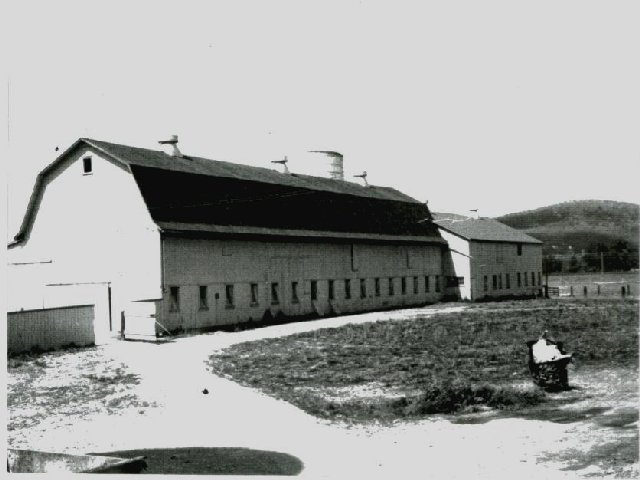
This barn stood at the northwest corner of the Canada Road farm. It was originally a tobacco shed. My notes from Ken Burnside say that there was once a store in the small stripping room attached to the barn.
When Bob moved to the Erwin Valley, tobacco was grown in the field west of the dairy barns, and he continued to grow it. I suspect that the value of the local tobacco crop was decreasing at the time because he converted the farm's tobacco shed into a dairy barn.
The size of the tobacco shed gives a clue to the value of the crop however; It was about twenty percent of the total barn space of the farm at the time. On Bob's Canada Road farm, the western-most barn was originally a tobacco shed and stripping room. This barn was about forty percent of that farm's barn space. Many other of the dairy barns of the mid 1950s started life as tobacco sheds.
Tobacco was a very labor- intensive crop because the plants had to be started early in the season under a shelter and transplanted into the field. They had to be covered with cheesecloth early in their growth, and later on, the fat juicy tobacco worms had to be plucked from the leaves. Once mature, the leaves were cut and bound and the bundles hung in the drying sheds.
The crop was valuable to the farmers because it brought cash money into the community from the outside world. The bundles of dried leaves were not perishable, and they had a high value for their weight... they were easily transported over long distances, unlike other local farm products as the 1800s became the 1900s.
The Town of Big Flats was the center of the local tobacco industry with many acres of excellent ground devoted to tobacco, and many households with second incomes from the local cigar-making industry. Tobacco from all the surrounding area was brought to Big Flats for sale and shipment.
Bob told me of his last tobacco crop. It wasn't all that big a crop, it required only one trip to Big Flats, and I believe that it was a horse- drawn wagon. When he arrived at the broker's he was given a price of $14 for the load. He looked at the guy and said "for that much I will take it back home and dump it in the field" The broker shrugged his shoulders and Bob took the load home and dumped it.


